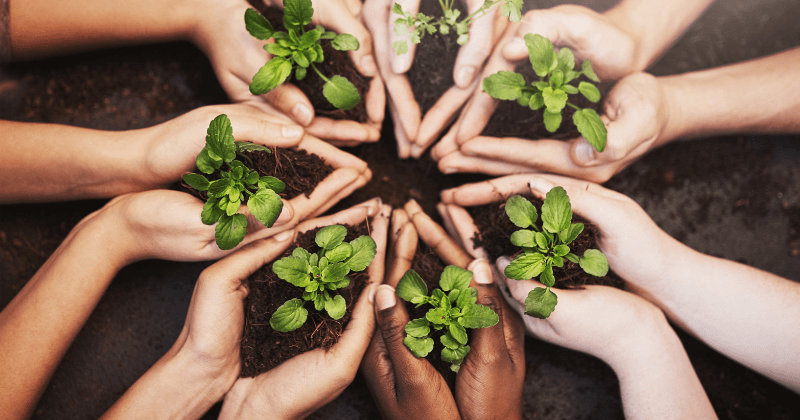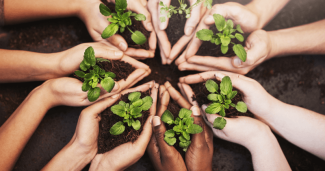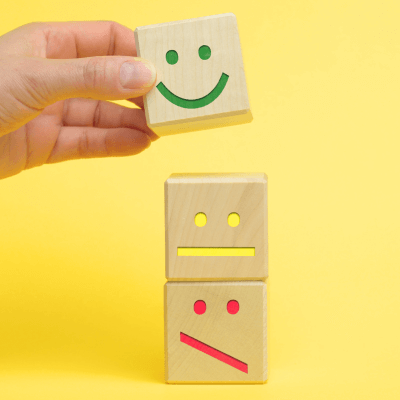Can We Befriend Nature After An Extreme Weather Event?

[Editor’s Note: Every month, MCN’s Director of Witness to Witness, Kaethe Weingarten, PhD, shares stories, resources, and helpful tips to support health care workers during these ongoing unprecedented times. Dr. Weingarten also offers a twice-monthly newsletter, filled with resources, recent articles, and her news and views. Sign up for the newsletter and grab bilingual resources on the Witness to Witness webpage.]
Recently, after climate-fueled hurricanes Fiona and Ian hit Puerto Rico and the southeastern United States, I was thinking about the conundrum of how to befriend “nature” and all its wonders when “nature” has created such disasters. That is, how do I appreciate the natural wonders that are all around us on this Earth and also register that life is subject to chaos-creating natural events, many of them more frequent and increasingly destructive, due to climate change? On the one hand, we have scientific evidence that being in nature is restorative for our health and on the other hand, we have evidence that nature can disrupt our health – physical, mental, and the health care systems themselves that provide our care -- when it deals catastrophic weather events.
The Positive Effects of Nature on Health
Research informs us of something most of us have experienced ourselves even if we can’t describe the responsible neuro-endocrine pathways. Scenes of nature trigger physically pleasurable sensations. Conversely, living in a high-stress environment can produce toxic stress, which has been deemed “public enemy number one.” Time in nature is considered the counterweight.
There is research that shows that urban environments --- as contrasted with natural ones – may be causal to higher rates of mental illness. Living in a city confers a 20% higher risk of an anxiety disorder and a 40% higher risk of a mood disorder. After 90-minute walks in a wooded natural area, participants had brain activity conducive to a lower risk of depression compared to the walkers in a high-traffic urban setting.
Much of the research evidence points to cognitive, emotional, and existential benefits of time in nature. In one review, researchers found that contact with nature was associated with increases in happiness, subjective well-being, positive affect, positive social interactions, and a sense of meaning and purpose in life, as well as decreases in mental distress.
With all the research demonstrating the positive impacts of nature on health, people wonder how much exposure to nature is “enough” to produce these purported positive effects. No definitive research answers this question, but research undertaken with 20,000 adults in the UK suggests that two hours a week – spread out or all at one time – seem to reliably produce positive outcomes on health and well-being.
The Negative Effects of Climate Change on Health
Using PubMed, I found nine systematic reviews of literature pertaining to “the negative effects of climate change on health.” Not surprisingly, most of the literature reviewed did not meet criteria for inclusion and so most of the articles based their conclusions on fewer than 20 research articles. Almost all the articles call for more research and decry the absence at this late date of well-designed studies. Some findings from these few articles include:
Climate change has many impacts, including on:
- Infectious diseases through exposure to pathogens in the water supply due to flooding.
- Food insecurity. Already, 52.5% of Africa’s population has been made food insecure by human-made practices that create climate changes.
- Physical activity due to air pollution, extreme temperatures, and other disasters. This will disproportionately affect people with chronic diseases, higher body mass index and the elderly.
- Negative mental health as a result of human-made practices that affect climate and the natural disasters that follow from these practices. One form that mental health distress takes is called “eco-anxiety,” related to the awareness of the harm done by human-made practices that result in climate change.
The WHO concludes its report on human-made practices that produce climate change in this way: “Climate change -- the biggest health threat facing humanity.” The facts the report highlights are:
- “Climate change affects the social and environmental determinants of health – clean air, safe drinking water, sufficient food, and secure shelter.
- Between 2030 and 2050, climate change is expected to cause approximately 250 000 additional deaths per year, from malnutrition, malaria, diarrhea and heat stress.
- The direct damage costs to health (i.e. excluding costs in health-determining sectors such as agriculture and water and sanitation), is estimated to be between USD 2-4 billion/year by 2030.
- Areas with weak health infrastructure – mostly in developing countries – will be the least able to cope without assistance to prepare and respond.
- Reducing emissions of greenhouse gases through better transport, food and energy-use choices can result in improved health, particularly through reduced air pollution.”
Inequities in Climate Impact
It is important to understand and then emphasize that the negative effects of human-made practices that create climate change are not distributed equally on Earth. Scientists have published more than 400 peer-reviewed studies looking at weather extremes around the world. Extreme weather events are much more likely to negatively impact poorer communities. “Overwhelmingly, extreme weather events exacerbate societal and systemic inequalities that already run deep….That climate change inequality exists is far from a revelation. But nowhere is it spotlighted more harshly than in the wake of a disaster.” Or, put another way, “It is a perverse reality that the nations positioned to manage best, adapting most successfully to their new ecosystems, are likely to be the same nations responsible for most of the world’s carbon output.”
How Can We Recover or Create a Beneficent Relationship to Nature?
Ecosystems are extremely complex, and disruptions to them have consequences, not just to the animals and plants living within that ecosystem but to the human systems that rely on the ecosystem and climate stability for health, well-being, and sustenance – and, once degraded, feedback loops may begin, intensifying the damage. Even a single hurricane can produce disruption to the natural environment leading to reductions in biodiversity, which negatively impact life on Earth and also accelerate climate change, resulting in more extreme weather events. The last sentence contains a principle, clearly articulated by an Italian environmental scientist, Elisa Furlan. “We are living in a world where everything is interconnected. …Climate-related and human-made hazards have become increasingly systemic, the result of the complex and dynamic interactions happening among human, economic, political, and natural systems.”
Because we are interconnected, a climate-fueled disaster can have a big impact on our well-being. Not only is there the work of recovering from the disaster but there is the work of recovering one’s relationship to the natural element responsible for the disaster, be it fire, water, wind or heat. Many people experience fear, sadness, grief, trauma, anxiety, and more when re-entering that natural place that was, before the disaster, home. Or even for some, a sanctuary. Alternatively, those of us without close relationships to a natural place may wish to find health benefits to being in nature after a disaster. In both cases, the natural environment may still confer health benefits in its degraded or altered state, and, in both cases, the answer is recognizing our interconnectedness and the reciprocity between a person and a natural ecosystem. We contribute to its well-being, as it contributes to ours.
These are some suggestions for recovering a beneficent relationship to nature so that we can benefit from all its positive, healthful effects. In doing so, we are more likely to lessen both our own climate anxiety and climate grief, should we experience these.
This may seem a strange starting point, but there is a practice in certain forms of therapy, called externalization, that may be helpful. We are used to blaming wildfires or flooding for disasters, but we could shift and start saying and thinking something like “human-made practices that create climate change fueled this fire that is now engulfing forests and traveling into residential communities, destroying my home.” Or, “human-made practices of climate change are causing billions of tons of ice to melt, raising sea-levels and leading to floods.” Poor fire. Poor water. They are thus as much “victims” as we. If we think of Nature’s elements in this way, it may be easier to “forgive” these elements and develop or recover a positive relationship to them. Or, perhaps a reminder that human nature is indistinguishable from nature can help. “I” -- we -- are part of “it” and are therefore part of the solution as well as part of the problem.
Practically, experimenting with small doses of “play” with the element that has been destructive may also help. Put your foot into the river that swelled or the ocean that surged and feel the pleasure of that. Make a small, contained fire and tell funny stories by it or roast marshmallows. Go “forest bathing,” a Japanese mindfulness practice called shinrin-yoku to heighten one’s senses while experiencing nature. Whatever the element, create a benign experience with it.
Often in the aftermath of a climate-related disaster, there are signs of nature healing itself. Watching the flowers that bloom in a fire-ravaged forest can be salutary. Seeing this as an example of resilience in nature can also generate sympathy and relief.
We can also learn about the ways that more nature not less can be restored to mitigate the effects of human-made practices that contribute to climate-change.
We can join the many movements for climate activism that support rather than blame Nature. Here are 36 organizations globally that are working to solve climate change. There are others. For instance, I am a member of 1000 Grandmothers and they are not on the list. Look in your community and see what climate activism groups exist. That is probably the best place to start. Once you have identified a group that you like, invite your friends. Collectively we are more likely to figure out how to embrace nature even after we have experienced an extreme weather event caused by human-made practices that create climate change.
Finally, all of the arts have comforting contributions to make, whether we are listening to sounds of nature, viewing artistic masterpieces or reading prose or poetry about nature. MCN’s Associate Director of Communications, Claire Seda, reminded me of a poem I love and return to often to bask in the solace it offers. We give Wendell Berry (b.1934) the last word.
The Peace of Wild Things
When despair for the world grows in me
and I wake in the night at the least sound
in fear of what my life and my children's lives may be,
I go and lie down where the wood drake
rests in his beauty on the water, and the great heron feeds.
I come into the peace of wild things
who do not tax their lives with forethought
of grief. I come into the presence of still waters.
And I feel above me the day-blind stars
waiting with their light. For a time
I rest in the grace of the world, and am free.
1 Just one set of facts can make this point. “The United States is responsible for about a fifth of all historical emissions, many of which hang in the air for centuries and are still heating the planet now. Today the average American creates 200 times as much carbon pollution as the average person living in Congo, Somalia, Ethiopia or Niger.” [https://www.nytimes.com/interactive/2022/10/26/magazine/visualization-climate-change-future.html] At just one degree hotter, global inequality is at least 25% greater than at no temperature rise.
- Log in to post comments






